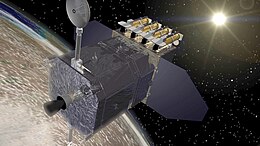Solar Dynamics Observatory
 |
|
| Mission type | Solar research |
|---|---|
| Operator | NASA GSFC |
| COSPAR ID | 2010-005A |
| SATCAT no. | 36395 |
| Website | http://sdo.gsfc.nasa.gov |
| Mission duration | 5–10 years |
| Spacecraft properties | |
| Launch mass | 3,100 kilograms (6,800 lb) |
| Dry mass | 1,700 kilograms (3,700 lb) |
| Payload mass | 290 kilograms (640 lb) |
| Start of mission | |
| Launch date | 11 February 2010, 15:23:00 UTC |
| Rocket | Atlas V 401 |
| Launch site | Cape Canaveral SLC-41 |
| Contractor | ULA |
| Orbital parameters | |
| Reference system | Geocentric |
| Regime | Geosynchronous |
| Longitude | 102° west |
| Semi-major axis | 42,164.71 kilometers (26,199.94 mi) |
| Eccentricity | 0.0002484 |
| Perigee | 35,783 kilometers (22,235 mi) |
| Apogee | 35,804 kilometers (22,248 mi) |
| Inclination | 28.05 degrees |
| Period | 1436.14 minutes |
| Epoch | 24 January 2015, 10:48:18 UTC |
 |
|
The Solar Dynamics Observatory (SDO) is a NASA mission which has been observing the Sun since 2010. Launched on February 11, 2010, the observatory is part of the Living With a Star (LWS) program. The goal of the LWS program is to develop the scientific understanding necessary to effectively address those aspects of the connected Sun–Earth system directly affecting life and society. The goal of the SDO is to understand the influence of the Sun on the Earth and near-Earth space by studying the solar atmosphere on small scales of space and time and in many wavelengths simultaneously. SDO has been investigating how the Sun's magnetic field is generated and structured, how this stored magnetic energy is converted and released into the heliosphere and geospace in the form of solar wind, energetic particles, and variations in the solar irradiance.
The SDO spacecraft was developed at NASA's Goddard Space Flight Center in Greenbelt, Maryland, and launched on February 11, 2010, from Cape Canaveral Air Force Station. The primary mission is scheduled to last five years and three months, with expendables expected to last for ten years. Some consider SDO to be a follow-on mission to the Solar and Heliospheric Observatory (SOHO).
SDO is a 3-axis stabilized spacecraft, with two solar arrays, and two high-gain antennas, in an inclined geosynchronous orbit around Earth. The spacecraft includes three instruments: the Extreme Ultraviolet Variability Experiment (EVE) built in partnership with the University of Colorado at Boulder's Laboratory for Atmospheric and Space Physics (LASP), the Helioseismic and Magnetic Imager (HMI) built in partnership with Stanford University, and the Atmospheric Imaging Assembly (AIA) built in partnership with the Lockheed Martin Solar & Astrophysics Laboratory. Data which is collected by the craft is made available as soon as possible, after it is received.
...
Wikipedia
